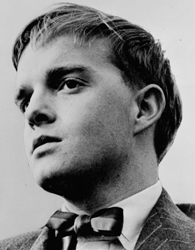Writer Truman Capote emerged from the small town of Monroeville, Alabama, to become one of the most visible writers of the 1950s and ’60s. His book “In Cold Blood” inspired a new form of reporting that came to be called New Journalism, while his short stories and novels, like “Breakfast at Tiffany’s” often reflected the cultural landscape of New York City society.
Truman Capote’s Early Days
Truman Capote was born Truman Streckfus Persons on September 30, 1924. His parents, Archulus Persons and Lillie Mae Faulk, lived in New Orleans, although Truman’s salesman father regularly left town in search of new professional job opportunities. His mother, who was a 16-year-old beauty queen when the pair met, was often left to tend to Truman alone.
When the boy was four, his parents officially divorced and he and his mother moved to Monroeville, where Truman became close friends with his young neighbor Harper Lee. Years later, Lee wrote Truman into her novel “To Kill a Mockingbird” as the character Dill; Truman wrote Lee into his first novel, “Other Voices, Other Rooms,” as the character Idabel Tompkins.
When Truman was 10, his mother married Cuban-born businessman Joe Capote, whose name Truman adopted. They moved to New York City where Mr. Capote lived. Capote attended several prep schools but never graduated. Instead, when he was 17, Capote took a job at The New Yorker magazine.
Capote later explained why he took the job in lieu of attending school: “I was determined never to set a studious foot inside a college classroom. I felt that either one was or wasn’t a writer, and no combination of professors could influence the outcome. I still think I was correct, at least in my own case.”
Sources in this Story
- Biography.com: Truman Capote
- The New York Times: Truman Capote: His Life and Work
- PBS American Masters: Truman Capote: About the author
- The Guardian: Truman Capote in the frame
- Portfolio at NYU: Truman Capote, In Cold Blood
- The Independent: The inside story of Truman Capote’s masked ball
- The Weekly Standard: A Lad of the World
Capote’s Notable Accomplishments
Capote contributed to The New Yorker’s column “Talk of the Town.” He also wrote for other publications and completed his first novel, “Other Voices, Other Rooms,” which was published in 1948.
After his first book was published, Capote achieved a measure of wealth and fame, which he relished and exploited. He frequently appeared at parties, restaurants and theater openings. His second novel, “Breakfast at Tiffany’s” (1958), reflected many of the themes he observed in New York culture.
In the 1950s and ’60s, Capote also became involved with the filmmaking industry. David O. Selznick, who had produced “Gone With the Wind,” asked Capote to contribute dialogue for Montgomery Clift and Selznick’s wife, Jennifer Jones, in the film “Indiscretion of an American Wife.” After that, Capote helped on other projects, including “Beat the Devil” and “The Innocents.”
Capote had a knack for journalism and a desire to invent a new narrative style. He developed an interview technique that would help him accomplish his canonical nonfiction novel, “In Cold Blood” (1966). Capote referred to his method as “the secret to the art of interviewing.” The process involved sharing personal details with his interviewees and reversing the normal relationship between subjects and reporters. Capote also trained himself to memorize passages of dialogue and transcribe them later. The intimacy he achieved through his investigative reporting helped usher in a new era of reporting known as New Journalism.
The publication of “In Cold Blood” brought Capote even more fame and wealth. In June 1966, the writer decided to give himself a “great, big, all-time spectacular present.” Capote’s Black and White Ball took place at the Plaza Hotel. Guests were dressed only in black and white and wore masks to disguise themselves. Capote spent the evening visiting tables, asking: “Aren’t we having the most wonderful time? I love this party.”
Truman Capote and his Work
- “Other Voices, Other Rooms”
- “Breakfast at Tiffany’s: A Short Novel and Three Stories”
- “In Cold Blood”
- “A Christmas Memory”
- “Music for Chameleons”
- “Capote” (DVD)
The Rest of the Story
Despite the many friends he made in New York, Capote ended his life with a great deal of enemies. Capote’s final work, “Answered Prayers,” was intended to be his masterwork, exposing the secrets of the wealthy Manhattan society. The first chapter was published in Esquire in 1975 and was so offensive to some of his friends that Capote became persona non grata in many of his familiar social circles.
Capote’s constant partying masked a painful reality that emerged after he finished “In Cold Blood.” The dark subject matter and intimacy he achieved with the murderers disturbed Capote, causing him to drink in excess and take tranquilizers to calm his nerves. His longtime partner, Jack Dunphy, disapproved of his drinking and drug use and the two eventually separated. When Capote lost many of his friends after publishing the “Answered Prayers” excerpt, he found himself increasingly lonely and unhappy.
In 1980, Capote published “Music for Chameleons,” a collection of fiction and nonfiction. Although the collection sold well, Capote continued to drink and battle a drug addiction. He died on August 25, 1984, in Los Angeles.
This article was originally written by Isabel Cowles; it was updated September 28, 2017.











